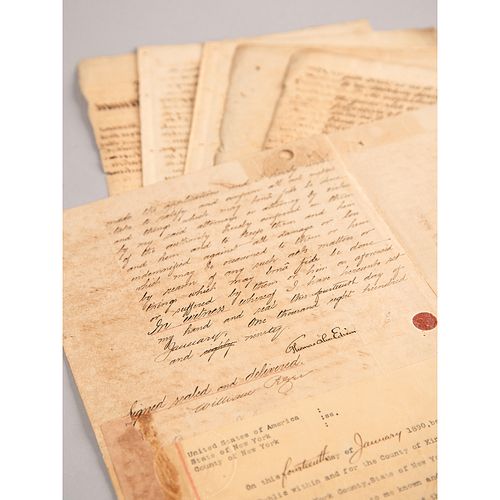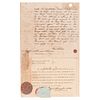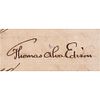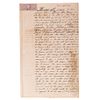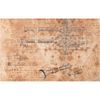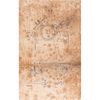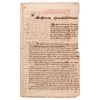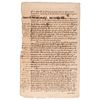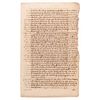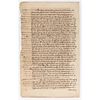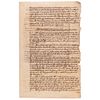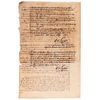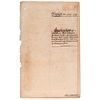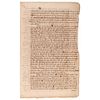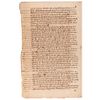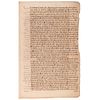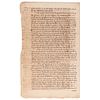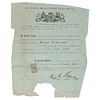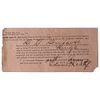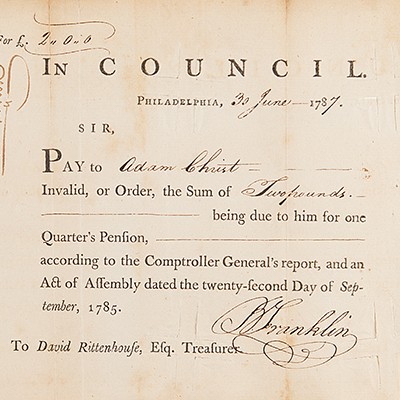Thomas Edison Document Signed for Phonograph Patent (1890)
Two ways to bid:
- Leave a max absentee bid and the platform will bid on your behalf up to your maximum bid during the live auction.
- Bid live during the auction and your bids will be submitted real-time to the auctioneer.
Bid Increments
| Price | Bid Increment |
|---|---|
| $0 | $5 |
| $50 | $10 |
| $200 | $25 |
| $500 | $50 |
About Auction
Jan 10, 2024
RR Auction support@rrauction.com
- Lot Description
Historic manuscript DS, signed “Thomas Alva Edison,” one page both sides, 8 x 13, January 14, 1890. In part: "I, Thomas Alva Edison, of Llewellyn Park in the State of New Jersey in the United States of America, Electrician, the sole and original inventor of an invention which I have termed 'Improvement in Phonographs' do hereby appoint Robert Leycester Upton, William Kearnes Eddis, Henry Cooper Eggar and George William Frederick Buckland...jointly and severally my attornies and attorney in my name to apply in the Empire of India for the grant to me of the sole and exclusive privilege and right within the said Empire of making selling and using the said invention and of authorising others so to do." Affixed below Edison's signature are a notarized document certifying Edison as the signer, and a certification of the notary's credentials.
Includes a manuscript "application of Thomas Alva Edison for leave to file a specification under Part I of the Invention and Designs Act in respect of an Invention for Improvements in Phonographs," totaling eleven pages on six sheets, stamped at the head: "Received in the Office of the Secretary of the Government of India...on the 3 July 1890." The manuscript describes Edison's invention, designed to "increase the simplicity in construction and operation of the phonograph, by decreasing the number of parts of which the machine is composed, by lessening or avoiding the necessity for adjustment of the various parts in practice and by increasing the convenience of manipulation of the machine." The application is signed twice by Henry Cooper Eggar, "H. C. Eggar," to whom Edison had granted power of attorney for this purpose. Includes two further pages of printed schematic diagrams for parts corresponding to those described in the application. In overall very good condition, with scattered soiling and staining (very heavy to the two printed diagrams), tears and creases to one of the notary certificates, and chipping to edges of the manuscript application.
In 1877, when Edison invented the phonograph, the first device for recording and playing back sound, he thought that its main use would be to record speech in business settings, which could then be played back and transcribed. This patent application represents an early improvement in the area, simplifying and refining the machine. He made improvements upon the phonograph—and its recording media—throughout the 1880s, pioneering the use of wax cylinders as a means of sound recording and reproduction. Edison's phonograph would eventually be adopted primarily for entertainment purposes, bringing music into millions of American households. The phonograph was considered the first great invention of Edison's career, and remained his life-long favorite. A supremely desirable archive pertaining to Edison's world-changing innovation. - Shipping Info
-
Bidder is liable for shipping and handling and providing accurate information as to shipping or delivery locations and arranging for such. RR Auction is unable to combine purchases from other auctions or affiliates into one package for shipping purposes. Lots won will be shipped in a commercially reasonable time after payment in good funds for the merchandise and the shipping fees are received or credit extended, except when third-party shipment occurs. Bidder agrees that service and handling charges related to shipping items which are not pre-paid may be charged to a credit card on file with RR Auction. Successful international Bidders shall provide written shipping instructions, including specified Customs declarations, to RR Auction for any lots to be delivered outside of the United States. NOTE: Declaration value shall be the item’(s) hammer price and RR Auction shall use the correct harmonized code for the lot. Domestic Bidders on lots designated for third-party shipment must designate the common carrier, accept risk of loss, and prepay shipping costs.
-
- Buyer's Premium



 EUR
EUR CAD
CAD AUD
AUD GBP
GBP MXN
MXN HKD
HKD CNY
CNY MYR
MYR SEK
SEK SGD
SGD CHF
CHF THB
THB